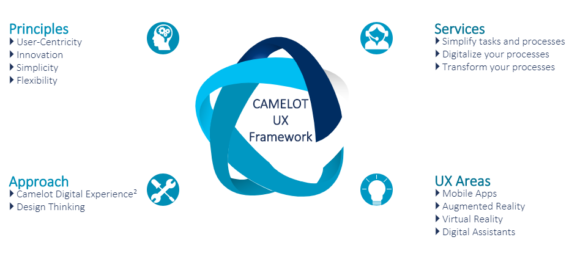Looking at the digital transformation objectives, we often see the key focus on automation. Whether it is simple automated rules or sophisticated solutions based on artificial intelligence like optical character recognition (OCR). But still a lot of human interaction is needed for corporate business processes.
Considering that digitalization and transformation usually also mean that new and different tools are introduced, it is easy to imagine the impact on employees needing to adapt to those tools and a new way of working. The way humans can interact with machines has changed enormously in recent years. Classical web-based interfaces are still the means of choice, but the full potential can only be achieved if further input devices are considered and connected together along the digital transformation. These include voice and gesture control, digital assistants or other AI-based interfaces. In addition, we see a growing fusion of the real and digital environment via virtual or augmented reality, giving even more complexity and demands. This already shows how important a sound strategy for the overall user experience is!
A closer look should be given to the user experience, taking into account how important change management is for such transformation projects and how much impact bad change management can have, which can even lead to implemented changes being neglected. An examination of the user experience can be a big advantage to help smooth out the transition and ease the change management efforts. Ignoring the importance of this easily leads to major downsides like loss of trust or acceptance of the users, which may lead to the transformation being endangered.
What UX is really about
A huge misperception regarding UX is that it is only about a pretty user interface. But in reality, this is only a small fraction of what UX is really about. The user experience covers the complete interaction of a user from start to finish by covering the user’s real problems and requirements independently of devices and location.
Major cornerstones of UX areas are:
- Usability
- Accessibility
- Usefulness
Seamless integration of the different tools and steps is more and more in the spotlight of UX, especially looking at multiple tools being used within a process by one person.
The Camelot UX Framework
To cater to this need created by digitalization and transformation, Camelot developed its Camelot UX Framework that covers our approach for a successful user experience strategy and implementation.
As not all initiatives are of the same size, our framework provides three level of services for your company to benefit from an enhanced user experience:
Simplify tasks and processes
- We provide you with applications that fit your needs and reflect your current usage of processes and tasks.
- Using our design thinking approach, we put user-centricity first to achieve simplification and easily accessible applications for your employees and customers.
- Achieve higher responsiveness and reduction of process lead times by only transforming single tasks.
Digitalize your processes
- With an initial assessment, we evaluate your current digital maturity and identify processes with digitalization potential.
- A digitalization strategy using applications and tools is developed, including the design and integration of analogue processes.
- Development of applications and tools needed for digitalization of identified processes.
- Establishment of digital work within your company.
Transform your processes
- We drive the complete transformation and re-innovation of your processes and tasks for a next level user experience.
- As-is assessment and definition of the digitalization & user experience strategy.
- Support of tool selection process and fitness of infrastructure, whether you want to use the Cloud, on premise or hybrid solutions.
- Establishment of a digital user experience-based culture.
To find out more about our Camelot UX Framework and learn about our principles or customer success stories, contact us and start your own user experience journey with us!
We would like to thank Denis Schrodt for his contribution to this article.

